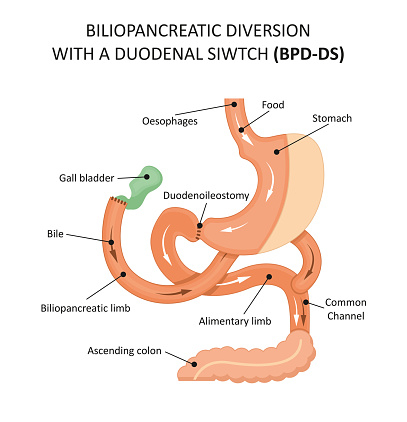Biliopancreatic Diversion with Duodenal Switch
A Guide to Advanced Bariatric Surgery for Transformational Weight Loss
Understanding Obesity and Surgical Weight Loss

What is Biliopancreatic Diversion with Duodenal Switch
BPD-DS is an advanced bariatric procedure that combines two surgical techniques:
- Sleeve gastrectomy to significantly reduce stomach size.
- Intestinal rerouting to limit absorption of calories and nutrients.
Unlike other surgeries, biliopancreatic diversion with duodenal switch addresses food intake and nutrient absorption. The result is a potent one-two punch against severe obesity, offering both restriction (less food can be eaten) and malabsorption (fewer calories and nutrients are absorbed).
How BPD-DS is Different
How the BPD-DS Procedure Works
- Step 1: A substantial portion of the stomach is removed, creating a stomach pouch shaped like a narrow tube.
- Step 2: The small intestine is divided and rearranged, so food bypasses much of the area where calories and nutrients are normally absorbed.
- Step 3: The digestive juices meet food closer to the colon, reducing calorie and nutrient absorption.
Most BPD-DS surgeries are performed using minimally invasive techniques (laparoscopy) for a safer, faster recovery.
Alternatives to
BPD-DS
Not every patient is a candidate for BPD-DS, and other options may be considered:
- Gastric sleeve surgery reduces the stomach’s size but does not change the intestines. It’s less complex but generally leads to less weight loss.
- Gastric bypass re-routes food past much of the stomach and upper small intestine, resulting in restriction and some malabsorption.
- Your surgeon will review all alternatives during your consultation, ensuring you choose a path tailored for your specific health needs.
Are You a Candidate for BPD-DS?
BPD-DS is typically recommended for:
- Individuals with a BMI of 50 or higher (severe obesity).
- Those with obesity-related health problems such as type 2 diabetes, high blood pressure, or elevated cholesterol.
- Patients who have not experienced lasting success with other medical weight loss methods.
This procedure may not be suitable for everyone. Alternative surgeries may be recommended for individuals with severe acid reflux or certain medical conditions. During your assessment, our team will guide you toward the safest and most effective treatment.
Risks and Complications
All major surgeries come with some risk. Understanding the biliopancreatic diversion with duodenal switch complications is crucial before making a decision.
- Nutritional deficiencies (especially vitamins A, D, E, K, and protein) requiring lifelong supplementation and monitoring.
- Bleeding, infection, or leakage at surgical connections (rare, but possible).
- Gastrointestinal issues such as diarrhea, gas, or bowel changes.
- Potential for long-term risks, including nutritional and metabolic complications that mandate regular medical follow-up.
Open discussion with your surgeon and our care team is essential to weigh the benefits, risks, and your preparedness for post-surgery commitments.
Are You a Candidate for BPD-DS?
- Initial hospital stay is commonly one to two nights.
- Early recovery involves walking shortly after surgery, managing pain, and resuming light activity within days.
- Diet progression starts with clear liquids, then gradually introduces full liquids, pureed, and soft foods, before returning to a varied diet focused on high-protein and nutrient-rich choices.
- It is vital to stay hydrated, take all recommended vitamin and mineral supplements, and attend all scheduled follow-up appointments.
Close monitoring by our dietitian and clinical team will help you stay healthy and track your weight loss progress. We provide personalized meal plans and ongoing education to empower your long-term success.
Why Choose Best Life Bariatrics and Medical Weight Loss Center
- Personalized care that fits your unique goals and health history.
- Board-certified, experienced surgeons skilled in advanced bariatric techniques.
- Full-spectrum support before and after surgery, including nutritional, psychological, and lifestyle guidance.
- State-of-the-art facilities in Middleburg Heights and North Canton, designed for comfort, safety, and superior patient outcomes.
Take the First Step Toward Your Best Life
Suppose you’re ready to explore lasting weight loss and better health with biliopancreatic diversion with duodenal switch surgery, or want to compare your options. In that case, Best Life Bariatrics and Medical Weight Loss Center is here to help.
Contact us today for a personalized consultation and start living your best life.